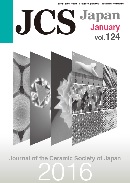124 巻, 1 号
(January)
選択された号の論文の33件中1~33を表示しています
- |<
- <
- 1
- >
- >|
-
2016 年 124 巻 1 号 p. H1-1
発行日: 2016年
公開日: 2016/01/01
PDF形式でダウンロード (853K) -
2016 年 124 巻 1 号 p. C1-1-C1-5
発行日: 2016年
公開日: 2016/01/01
PDF形式でダウンロード (2086K)
Feature: Ceramics Processing through Energy Consumption Reduction (Green Processing): Preface
-
2016 年 124 巻 1 号 p. P1-1-P1-3
発行日: 2016年
公開日: 2016/01/01
PDF形式でダウンロード (75K)
Feature: Ceramics Processing through Energy Consumption Reduction (Green Processing): Full papers
-
2016 年 124 巻 1 号 p. 1-6
発行日: 2016/01/01
公開日: 2016/01/01
PDF形式でダウンロード (4305K) -
2016 年 124 巻 1 号 p. 7-12
発行日: 2016/01/01
公開日: 2016/01/01
PDF形式でダウンロード (895K) -
2016 年 124 巻 1 号 p. 13-17
発行日: 2016/01/01
公開日: 2016/01/01
PDF形式でダウンロード (2297K) -
2016 年 124 巻 1 号 p. 18-22
発行日: 2016/01/01
公開日: 2016/01/01
PDF形式でダウンロード (2480K) -
2016 年 124 巻 1 号 p. 23-28
発行日: 2016/01/01
公開日: 2016/01/01
PDF形式でダウンロード (1494K) -
2016 年 124 巻 1 号 p. 29-33
発行日: 2016/01/01
公開日: 2016/01/01
PDF形式でダウンロード (3747K) -
2016 年 124 巻 1 号 p. 34-36
発行日: 2016/01/01
公開日: 2016/01/01
PDF形式でダウンロード (2025K) -
2016 年 124 巻 1 号 p. 37-41
発行日: 2016/01/01
公開日: 2016/01/01
PDF形式でダウンロード (1715K) -
2016 年 124 巻 1 号 p. 42-48
発行日: 2016/01/01
公開日: 2016/01/01
PDF形式でダウンロード (3845K) -
2016 年 124 巻 1 号 p. 49-54
発行日: 2016/01/01
公開日: 2016/01/01
PDF形式でダウンロード (4089K) -
2016 年 124 巻 1 号 p. 55-59
発行日: 2016/01/01
公開日: 2016/01/01
PDF形式でダウンロード (1043K) -
2016 年 124 巻 1 号 p. 60-65
発行日: 2016/01/01
公開日: 2016/01/01
PDF形式でダウンロード (544K) -
2016 年 124 巻 1 号 p. 66-69
発行日: 2016/01/01
公開日: 2016/01/01
PDF形式でダウンロード (1459K) -
2016 年 124 巻 1 号 p. 70-73
発行日: 2016/01/01
公開日: 2016/01/01
PDF形式でダウンロード (2231K)
Feature: Ceramics Processing through Energy Consumption Reduction (Green Processing): Technical report
-
2016 年 124 巻 1 号 p. 74-78
発行日: 2016/01/01
公開日: 2016/01/01
PDF形式でダウンロード (1874K)
Feature: Ceramics Processing through Energy Consumption Reduction (Green Processing): Notes
-
2016 年 124 巻 1 号 p. 79-81
発行日: 2016/01/01
公開日: 2016/01/01
PDF形式でダウンロード (1206K) -
2016 年 124 巻 1 号 p. 82-84
発行日: 2016/01/01
公開日: 2016/01/01
PDF形式でダウンロード (497K) -
2016 年 124 巻 1 号 p. 85-87
発行日: 2016/01/01
公開日: 2016/01/01
PDF形式でダウンロード (1359K)
Regular Articles: Full papers
-
2016 年 124 巻 1 号 p. 88-91
発行日: 2016/01/01
公開日: 2016/01/01
PDF形式でダウンロード (3065K) -
2016 年 124 巻 1 号 p. 92-97
発行日: 2016/01/01
公開日: 2016/01/01
PDF形式でダウンロード (2758K) -
2016 年 124 巻 1 号 p. 98-102
発行日: 2016/01/01
公開日: 2016/01/01
PDF形式でダウンロード (1190K) -
2016 年 124 巻 1 号 p. 103-105
発行日: 2016/01/01
公開日: 2016/01/01
PDF形式でダウンロード (498K) -
2016 年 124 巻 1 号 p. 106-110
発行日: 2016/01/01
公開日: 2016/01/01
PDF形式でダウンロード (2082K) -
2016 年 124 巻 1 号 p. 111-115
発行日: 2016/01/01
公開日: 2016/01/01
PDF形式でダウンロード (2148K) -
2016 年 124 巻 1 号 p. 116-121
発行日: 2016/01/01
公開日: 2016/01/01
PDF形式でダウンロード (763K)
Regular Articles: Notes
-
2016 年 124 巻 1 号 p. 122-124
発行日: 2016/01/01
公開日: 2016/01/01
PDF形式でダウンロード (1580K) -
2016 年 124 巻 1 号 p. 125-128
発行日: 2016/01/01
公開日: 2016/01/01
PDF形式でダウンロード (1234K) -
2016 年 124 巻 1 号 p. 129-131
発行日: 2016/01/01
公開日: 2016/01/01
PDF形式でダウンロード (1159K)
Announcements
-
2016 年 124 巻 1 号 p. A1-1-A1-2
発行日: 2016年
公開日: 2016/01/01
PDF形式でダウンロード (86K) -
2016 年 124 巻 1 号 p. A1-3
発行日: 2016年
公開日: 2016/01/01
PDF形式でダウンロード (12K)
- |<
- <
- 1
- >
- >|
